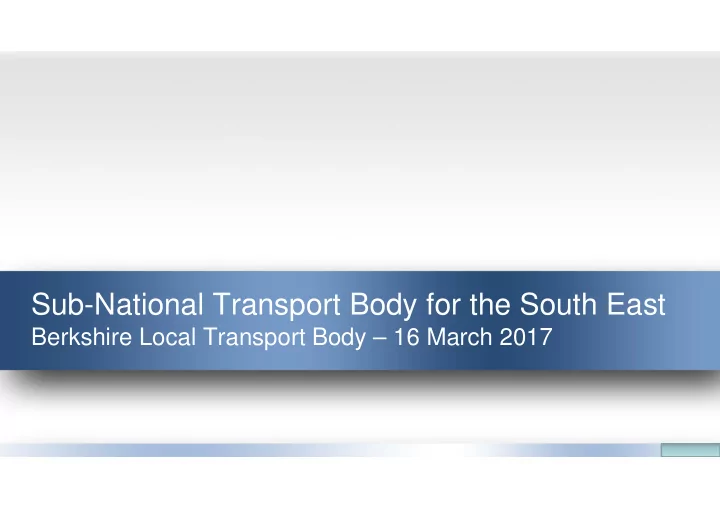

Sub-National Transport Body for the South East Berkshire Local Transport Body – 16 March 2017
Contents • Background to STB • Transport Strategy development • Proposed governance arrangements • Communications and engagement
Why have an STB in the South East? Percentage Share of UK GVA 2015 Source: ONS
Why have an STB in the South East?
Why have an STB in the South East? Planning Infrastructure National Government National National Planning Policy Highways Network Framework + Guidance England Rail Route Studies Route Strategies Sub-National LTAs LEPS Operators Local Local Planning Authorities LTP LGF Local Plans & IDPs
Why have an STB in the South East? Planning Infrastructure National Government National National Planning Policy Highways Network Framework + Guidance England Rail Route Studies Route Strategies Sub-National Sub National Transport Body LTAs LEPS Operators Local Local Planning Authorities LTP LGF Local Plans & IDPs
Why have an STB in the South East? • To ensure economy and contribution to Exchequer continue to grow • Speak with one voice to make the case for investment in our creaking infrastructure at a sub regional level • Improve the lot of the travelling public
Origin of STBs • Cities and Local Government Devolution Act 2016 • Multi Agency – Transport Authorities, LEPs, DfT, Highways England, Network Rail, ports and airports, transport operators, TfL • Statutory Bodies • Local delivery continues through LTP and LGF regimes
Transport for the South East • South East Seven (SE7) councils initiative: Brighton & Hove Surrey Hampshire West Sussex Kent East Sussex Medway • Local Economic Partnerships (SELEP, EM3, Coast to Capital) • Isle of Wight, Portsmouth, Southampton & Solent LEP • Berkshire Local Transport Body (Six Berkshire unitary authorities & Thames Valley Berkshire LEP)
Transport for the South East Potential roles and responsibilities: • specifying the investment priorities for the strategic road and rail networks • influencing, specifying and letting of future passenger rail franchises? • bus service franchising? • integrated and smart and ticketing? • delivery of major transport schemes?
Timeline 2017 • Finalise Geography • Shadow STB established (June 2017) • Development of the Transport Strategy; • Develop Governance arrangements and draft Proposal to Government; 2018 • Finalise Governance arrangements, constitution and Proposal to Government • Publish draft Transport Strategy; and • Undertake Transport Strategy consultation 2019 • Agreement to the Proposal by Government; • Preparation by Government of the Order establishing the STB; and • Parliamentary process and sign-off of the Order. • April 2019 Transport for the South East established
STB - Transport Strategy Vision The South East is a powerful driver of the UK economy and the nation’s major international gateway for people and businesses. We will grow the South East’s economy by delivering a quality, integrated transport system that makes us more productive and competitive, improves quality of life for all and protects the environment.
STB - Transport Strategy Strategic Priorities • promote economic growth by enhancing, managing and maintaining integrated transport networks, infrastructure and services to maximise their efficiency and improve their resilience; • promote social inclusion by improving connectivity and increasing the accessibility of the transport network; • protect our environment by investing in and promoting the use of sustainable forms of transport which minimise emissions, noise and the consumption of resources.
STB - Transport Strategy Priority Transport Objectives Economy improve surface access to international gateways; improve the reliability and resilience of the strategic networks promote efficient and sustainable means of freight distribution improve rail services and access to stations; promote regional interventions required for development and regeneration; Social improve access to jobs, services and leisure activities improve safety and reduce the number of people killed and seriously injured; Environment promote greater use of sustainable modes of transport reduce greenhouse gas emissions, local air pollution and noise from transport
STB - Transport Strategy • Better road and rail access to ports and airports • Improved cross-country orbital and radial road and rail routes linking South East economic areas • Reducing delays and bottlenecks on strategic road corridors such as the M25, M2, M3, M4, M20, A2, A3, A21, A27, A34, A259
STB Governance Network Rail DfT Highways England Bus 5 LEPS Operators Governance Train 16 LTAs TfL D&Bs Airports Users Ports
STB Governance Network Rail DfT Highways England Bus 5 LEPS Operators Governance Train 16 LTAs TfL D&Bs Airports Users Ports
STB Governance Partnership Board Senior Officer Transport Group Forum PMO Transport Communications Governance Strategy & Engagement
STB – Governance Partnership Board Decision making body for TfSE Voting Members Non-Voting Members (co-opted) - SE7 Leaders - Department for Transport - Berkshire Local Transport Body - Transport for London - Southampton, Portsmouth and Isle of - Highways England Wight - Network Rail - LEPs - Non-unitary representation (B&Ds) - Independent Chair of Transport Forum
STB – Governance Senior Officer Group Supports Partnership Board Membership: - Southampton, Portsmouth & - Senior Officers from SE7 Isle of Wight Authorities (one representative or 3) - Berkshire Local Transport - 5 LEP Directors/Senior Body (one representative) Officers
STB – Governance Transport Forum Engagement with broader group of Stakeholders Membership: - Ports - Independent Chair - Airports - LEPs (employer reps) - DfT - LTAs - TfL - Operators - Non unitary representatives - User Groups (B&Ds)
STB – Governance Partnership Board Decision making body for TfSE Voting Members Non-Voting Members (co-opted) - SE7 Leaders - Department for Transport - Berkshire Local Transport Body - Transport for London - Southampton, Portsmouth and Isle of - Highways England Wight - Network Rail - LEPs - Non-unitary representation (B&Ds) - Independent Chair of Transport Forum
Communications and Engagement • Script & Q&A • Further engagement with LEPs • Working Groups – Transport Strategy – Governance – Communications and Engagement
Key contacts Rupert Clubb Director Communities Economy & Transport East Sussex County Council rupert.clubb@eastsussex.gov.uk Mark Valleley Rachel Ford East Sussex County Council Surrey County Council mark.valleley@eastsussex.gov.uk rachel.ford@surreycc.gov.uk
STB - Transport Strategy
Recommend
More recommend